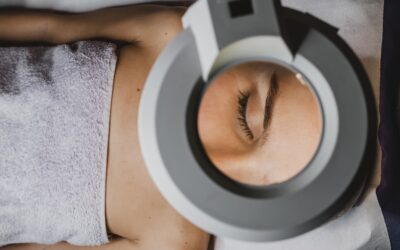One of the biggest misconceptions about Laser Hair Removal Maintenance is that it involves constant treatments to prevent hair from growing back. In reality, when laser hair removal is performed correctly with medical-grade equipment, proper settings, and skilled technique, clients can achieve up to 98% permanent hair removal. What many people call “maintenance” is simply treating the few remaining hairs left after completing a full, properly executed treatment series.
Understanding True Permanent Hair Removal
Laser hair removal works by permanently destroying hair follicles during their active growth phase. When done correctly, these treated follicles cannot regenerate or produce new hair. The key word here is “permanent” – once a follicle is properly treated, it’s eliminated for good.
However, not every hair follicle is active during each treatment session. Hair grows in cycles, and only approx. 10-20% of follicles in the active growth phase (called anagen) at your sessions can be effectively treated by laser energy. This is why multiple sessions are necessary and why a small percentage of hairs may remain after completing an initial treatment series.
What Laser Hair Removal “Maintenance” Really Means
When practitioners talk about maintenance treatments, they’re not referring to keeping previously treated areas hair-free. Instead, they’re addressing the small number of hair follicles that were missed during the original treatment series. These remaining hairs fall into several categories:
Some follicles were dormant during all treatment sessions and never received laser energy. A few hairs may have been in transitional growth phases that made them less responsive to treatment. Hormonal changes over time can sometimes activate previously dormant follicles. New hair growth from follicles that were too fine or light to be detected during initial treatments.
With proper laser hair removal technique using appropriate equipment, most clients find they can literally count the remaining hairs after completing their treatment series. These aren’t hundreds or thousands of hairs requiring extensive maintenance – they’re typically fewer than 50 scattered hairs across the entire treated area.
These maintenance sessions shouldn’t need to be performed more than once per year. Eventually, most clients will only have a small handful of random hairs permanently.
Achieving 98% Permanent Hair Removal
The key to achieving near-complete permanent hair removal lies in proper treatment protocols. This includes using the right laser type for your skin and hair combination, scheduling treatments at optimal intervals to catch different growth cycles (8-12 weeks for the body areas), ensuring adequate energy levels for effective follicle destruction, and completing the full recommended treatment series without skipping sessions.
When these factors align, clients regularly achieve 95-98% permanent hair removal. The remaining 2-5% represents those final stubborn hairs that may need individual attention during occasional touch-up appointments.
When Touch-Up Treatments Are Needed
Annual Touch-Ups
Some clients prefer annual touch-up appointments as a preventive measure. During these sessions, any new hair growth is addressed before it becomes noticeable. Annual touch-ups are particularly popular for highly visible areas like the face, where even a few stray hairs can be bothersome.
These yearly appointments usually involve treating just a handful of individual hairs and can often be completed in only a few minutes. Many clients schedule annual touch-ups around the same time each year, often before summer when they’ll be wearing less clothing or before special events.
Touch-Ups Every Few Years
Other clients find they only need touch-up treatments every 2-3 years. This schedule works well for people who achieved excellent results from their initial treatment series and only notice occasional new hair growth over time.
The advantage of spacing touch-ups further apart is cost savings and convenience. However, it may mean addressing slightly more hair during each appointment, as some new growth has had more time to develop.
Factors That Influence Touch-Up Frequency
Several factors can affect how often you might need touch-up treatments:
Hormonal changes due to pregnancy, menopause, or medical conditions can stimulate new hair growth, but don’t worry, this does not mean that all your previous sessions went to waste.
Certain medications may increase hair production in treated areas. Age-related hormonal shifts can activate previously dormant follicles. Genetic factors that influence hair growth patterns throughout life.
It’s important to understand that these factors don’t cause previously treated hairs to grow back. Instead, they may stimulate new growth from follicles that weren’t active during your original treatment series. Even this new growth will more than likely be only a fraction of the density of hair that you had prior to laser sessions.
Identifying Early Signs of Regrowth
Knowing what to look for can help you determine when a touch-up appointment might be beneficial. True regrowth after proper laser hair removal is minimal, but here are signs that a touch-up may be helpful:
Counting Individual Hairs
After completing a proper laser hair removal series, you should be able to count individual remaining hairs rather than seeing patches or areas of growth. If you notice more than 15-20 scattered hairs across a large treatment area like the legs or Brazilian, or more than 10 hairs in a small area like the upper lip, a touch-up appointment may be worthwhile.
New Growth Patterns
Sometimes new hair growth appears in patterns that weren’t present during your original treatments. This might include a few hairs along the bikini line that weren’t there before, or several hairs on the chin that have appeared months or years after facial hair removal. These represent newly activated follicles from hormonal changes, rather than regrowth from treated areas.
Texture and Color Changes
Occasionally, remaining hairs may become darker or coarser over time due to hormonal changes. While the number of hairs hasn’t increased, their visibility has, making touch-up treatment worthwhile for aesthetic reasons.
Seasonal Considerations
Some people notice that fine hairs become more apparent during certain seasons. Summer sun exposure can make light hairs more visible against tanned skin, while winter clothing may cause you to pay less attention to hair growth. Regular visual checks throughout the year help identify when touch-ups might be beneficial.
Scheduling Your Touch-Up Appointments
Proper scheduling ensures you get the most value from touch-up treatments while maintaining smooth, hair-free results.
Planning Ahead
The best time to schedule touch-up appointments is before hair becomes visually bothersome. This usually means booking your appointment when you first notice new growth rather than waiting until it becomes obvious. Early intervention typically requires less treatment time and achieves better results.
Seasonal Timing
Many clients find it helpful to schedule touch-ups seasonally. Spring appointments prepare skin for summer exposure, while fall treatments address any summer growth before it becomes established. Choose timing based on when smooth skin is most important to you.
Coordinating with Life Events
Consider scheduling touch-ups before important life events like weddings, vacations, or professional photo sessions. Planning 3-4 weeks ahead ensures any treated hairs will have shed out for your trip or event.
Tracking Your Results
Keeping simple records of when you notice new growth helps establish your personal touch-up schedule. Note the date, location, and approximate number of new hairs. Over time, this creates a pattern that helps predict when future touch-ups might be needed.
What to Expect During Touch-Up Sessions
Touch-up appointments are typically much quicker and easier than original treatment sessions. Since you’re only addressing a small number of scattered hairs, the process is fast and usually very comfortable.
Some laser technicians prefer for you to not shave the area like you did for your first series of sessions. This way, the few, random hairs can be marked by a white pencil, than quickly shaved and lasered without the need to laser the entire area again.
Most touch-up sessions take 15-45 minutes depending on the treatment area and number of hairs being addressed. The energy settings may be adjusted since you’re treating individual hairs rather than dense growth. Recovery time is minimal since less skin area is being treated.
Many clients find touch-up sessions much less uncomfortable than their original treatments, both because fewer hairs are being treated and because they’re familiar with the process.
Maximizing Your Investment
To get the most value from your laser hair removal investment, focus on completing your initial treatment series properly rather than trying to save money by skipping sessions. A thorough initial treatment dramatically reduces the need for frequent maintenance and ensures you achieve the best possible long-term results.
Work with experienced practitioners who use appropriate laser equipment for your skin and hair type. Follow all pre- and post-treatment guidelines to optimize results from each session.
Common Myths About Laser Hair Removal Maintenance
Several misconceptions persist about laser hair removal maintenance that can create unrealistic expectations:
Myth: Hair always grows back after laser treatment and requires constant maintenance.
Reality: Properly treated hair follicles are permanently destroyed and cannot regrow.
Myth: You need maintenance treatments every few months forever.
Reality: Most clients need touch-ups once per year or less when treated with an actual laser and correct settings.
Myth: Maintenance treatments are as extensive as original treatments.
Reality: Touch-ups typically address fewer than a dozen scattered hairs and are usually quick and cost much less.
Myth: Laser hair removal isn’t really permanent.
Reality: When done properly, laser hair removal achieves 95-98% permanent hair reduction.
Making an Informed Decision
Understanding what maintenance really means helps you make informed decisions about laser hair removal. When you know that “maintenance” involves treating a countable number of individual hairs rather than ongoing extensive treatments, the long-term value becomes clear.
Quality initial treatment is the foundation of minimal maintenance needs. Choose practitioners who prioritize thorough results over quick treatments, and be prepared to complete your full treatment series as recommended. This approach leads to the highest success rates and the least need for ongoing maintenance.
Remember that achieving 98% permanent hair removal means you’ll spend minimal time and money on touch-ups compared to the ongoing costs and time commitment of shaving, waxing, or other temporary hair removal methods. The small investment in occasional touch-up treatments pays for itself many times over in convenience and confidence.
FAQ
Is laser hair removal really permanent?
Yes! When laser hair removal is performed correctly with medical-grade equipment, proper settings, and skilled technique, clients can achieve up to 98% permanent hair removal. Average of 85-90%. Once a follicle is properly treated during its active growth phase, it’s eliminated permanently and cannot regenerate or produce new hair.
Why do I need maintenance if laser hair removal is permanent?
“Maintenance” doesn’t mean keeping previously treated areas hair-free—it addresses the small number of follicles missed during the original treatment series. These include dormant follicles that weren’t active during any session, hairs in transitional growth phases, or newly activated follicles from hormonal changes. You’re typically treating small, random areas of fewer than 50 scattered hairs, not hundreds.
How often will I need touch-up treatments?
Most clients need touch-ups once per year or less. Some prefer annual appointments as preventive measures, while others only need treatments every 2-3 years. Annual touch-ups usually involve treating just a handful of hairs and can take only a few minutes.
What causes hair to grow back after laser treatment?
Hair doesn’t “grow back” after proper treatment—those treated follicles are permanently destroyed. New growth comes from follicles that were dormant during all original sessions, hormonal changes that activate previously dormant follicles, or certain medications that increase hair production. Even this new growth is typically a fraction of original hair density.
How many hairs should remain after completing laser treatment?
With proper technique and appropriate equipment, most clients can literally count the remaining hairs after completing their treatment series—typically fewer than 50 scattered hairs across the entire treated area need to be treated per year or 2. If you’re noticing more than 15-20 scattered hairs, a touch-up may be worthwhile.




